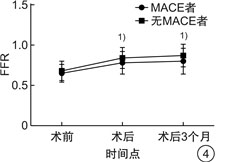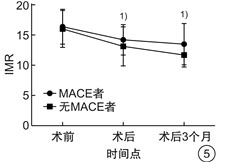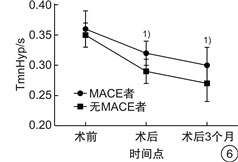Value of coronary function indexes in evaluating intervention effect and predicting adverse cardiovascular events in ACS patients
-
摘要: 目的 探讨冠状动脉功能学指标在急性冠状动脉综合征(acute coronary syndrome,ACS)患者介入效果评估及不良心血管事件发生预测中的价值。方法 选取2016年12月—2021年12月在本院收治的250例ACS患者,所有患者均行冠状动脉造影并行冠状动脉血流储备分数(fractional flow reserve,FFR)测量,纳入FFR < 0.80且至少存在单支冠状动脉主支病变狭窄≥70%者,均行经皮冠状动脉介入(percutaneous coronary intervention,PCI)治疗。检测患者行PCI术前后冠状动脉功能学指标微循环阻力指数(index of microcirculatory resistance,IMR)、充血状态下平均传导时间(mean conduction time in hyperemia,TmnHyp)及血清生化指标[肌酸激酶心肌同工酶(creatine kinase MB,CK-MB)、脑钠肽(brain natriuretic peptide,BNP)、心肌肌钙蛋白T(cardiac troponin T,cTnT)]。比较患者术前术后FFR、IMR、TmnHyp、CK-MB、BNP及cTnT变化,分析FFR、IMR值、TmnHyp与CK-MB、BNP及cTnT水平的相关性。记录入组患者PCI术后3个月不良心血管事件(MACE)发生率,分析FFR、IMR值与MACE事件发生的关系。结果 最终共纳入患者178例,与术前比较,ACS患者PCI术后FFR值增高,IMR及TmnHyp值降低(P < 0.05);血清CK-MB、BNP、cTnT水平下降(P < 0.05)。Pearson相关性分析结果显示术后FFR指数与CK-MB、BNP、cTnT水平呈负相关(r=-0.572、-0.720、-0.477,均P < 0.05);IMR指数与CK-MB、BNP、cTnT水平呈正相关(r=0.349、0.418、0.227,均P < 0.05);TmnHyp与CK-MB、BNP、cTnT水平呈正相关(r=0.315、0.222、0.302,均P < 0.05)。178例ACS行PCI术后3个月内发生MACE有52例,其中靶血管血运重建18例、非致死性心肌梗死16例、复发性心绞痛18例,总MACE发生率为29.21%。采用倾向匹配法,排除混杂因子,共得到36对。结果显示,MACE者FFR低于非MACE者(F时间为78.880,P < 0.05;F组间为21.168,P < 0.05),IMR、TmnHyp高于非MACE者(F时间分别为55.857、272.911,均P < 0.05;F组间分别为19.057、76.788,均P < 0.05)。结论 FFR、IMR及TmnHyp值的检测可对ACS患者PCI术后的疗效进行评估,且对其术后短期MACE的发生具有一定的预测价值。
-
关键词:
- 急性冠状动脉综合征 /
- 冠状动脉血流储备分数 /
- 冠状动脉微循环阻力指数 /
- 经皮冠状动脉介入治疗 /
- 预后
Abstract: Objective To explore the value of coronary function indexes in evaluating intervention effect and predicting adverse cardiovascular events in patients with acute coronary syndrome(ACS).Methods A total of 250 patients with ACS admitted to the hospital were enrolled between December 2016 and December 2021. All patients underwent coronary angiography and measurement of fractional flow reserve(FFR). The patients with FFR < 0.80 and single coronary stenosis ≥70% were included in the research, and all of which underwent percutaneous coronary intervention(PCI). The coronary function indexes (index of microcirculatory resistance[IMR], mean conduction time in hyperemia[TmnHyp]) and serum biochemical indexes(creatine kinase MB[CK-MB], blood natriuretic peptide[BNP], cardiac troponinT[cTnT]) were detected before and after PCI, respectively. The changes of FFR, IMR, TmnHyp, CK-MB, BNP and cTnT before and after surgery were compared. The correlations between FFR, IMR, TmnHyp and CK-MB, BNP, cTnT were analyzed. The incidence of major adverse cardiovascular events(MACE) in 3 months after PCI was recorded. The relationship between FFR, IMR and MACE was analyzed.Results There were 178 patients in the research finally. After PCI, FFR was increased, while IMR and TmnHyp were decreased(P < 0.05). After PCI, levels of serum CK-MB, BNP and cTnT were decreased(P < 0.05). The results of Pearson correlation analysis showed that postoperative FFR index was negatively correlated with CK-MB, BNP, cTnT levels(r=-0.572, -0.720, -0.477, P < 0.05). IMR index was positively correlated with CK-MB, BNP, cTnT levels(r=0.349, 0.418, 0.227, P < 0.05). TmnHyp was positively correlated with CK-MB, BNP and cTnT levels(r=0.315, 0.222, 0.302, P < 0.05). Among the 178 patients with ACS after PCI, there were 52 cases with MACE within 3 months, including 18 cases with targeted vessel revascularization, 16 cases with non-fatal myocardial infarction and 18 cases with recurrent angina pectoris, with total MACE incidence of 29.21%. The propensity matching method was applied to exclude confounding factors(36 pairs). The results showed that FFR in MACE patients was lower than that in non-MACE patients(Ftime=78.880, P < 0.05; Fbetween-group=21.168, P < 0.05), while IMR and TmnHyp were higher than those in non-MACE patients(Ftime=55.857, 272.911, P < 0.05; Fbetween-group=19.057, 76.788, P < 0.05).Conclusion The detection of FFR, IMR and TmnHyp can evaluate the curative effect in ACS patients after PCI, which is of certain predictive value for short-term MACE. -

-
表 1 ACS患者PCI术前后冠状动脉功能学指标变化情况
X±S 组别 例数 FFR IMR TmnHyp/s 术前 178 0.67±0.12 16.11±3.01 0.35±0.02 术后 178 0.83±0.13 13.44±3.08 0.30±0.02 t 11.505 8.269 21.312 P < 0.001 < 0.001 < 0.001 表 2 ACS患者PCI术前后血清生化指标水平变化情况
X±S 组别 例数 CK-MB/(U/L) BNP/(ng/L) cTnT/(μg/L) 术前 178 68.82±7.54 149.64±24.73 6.34±1.21 术后 178 59.79±9.57 136.58±23.79 5.27±0.97 t 9.882 5.079 9.257 P < 0.001 < 0.001 < 0.001 -
[1] Crea F, Libby P. Acute coronary syndromes: the way forward from mechanisms to precision treatment[J]. Circulation, 2017, 136(12): 1155-1166. doi: 10.1161/CIRCULATIONAHA.117.029870
[2] Al-Lamee RK, Nowbar AN, Francis DP. Percutaneous coronary intervention for stable coronary artery disease[J]. Heart, 2019, 105(1): 11-19. doi: 10.1136/heartjnl-2017-312755
[3] 杜秋红, 徐萍. 血浆sTWEAK水平与ACS病人冠状动脉病变严重程度及预后的关系分析[J]. 中西医结合心脑血管病杂志, 2019, 17(4): 557-559. https://www.cnki.com.cn/Article/CJFDTOTAL-ZYYY201904021.htm
[4] Thakur U, Khav N, Comella A, et al. Fractional flow reserve following percutaneous coronary intervention[J]. J Interv Cardiol, 2020, 2020: 7467943.
[5] 冠状动脉血流储备分数临床应用专家共识专家组. 冠状动脉血流储备分数临床应用专家共识[J]. 中华心血管病杂志, 2016, 44(4): 292-297. doi: 10.3760/cma.j.issn.0253-3758.2016.04.004
[6] 李瑶, 张海澄. 《ACS和血运重建紧急情况下心律失常管理共识2019》解读[J]. 中国循证心血管医学杂志, 2019, 11(9): 1025-1028. doi: 10.3969/j.issn.1674-4055.2019.09.01
[7] 亢爱春, 李阳, 季汉华, 等. NLR与NSTE-ACS冠脉病变程度及PCI术后心血管终点事件的相关性[J]. 河北医药, 2020, 42(8): 1206-1209. https://www.cnki.com.cn/Article/CJFDTOTAL-HBYZ202008021.htm
[8] 徐浩, 张治, 解学乾, 等. 冠脉生理功能评估软件(DEEPVESSEL FFR)与有创FFR在评估冠脉缺血中的对比研究[J]. 诊断学理论与实践, 2021, 20(4): 384-390. https://www.cnki.com.cn/Article/CJFDTOTAL-ZDLS202104013.htm
[9] Fearon WF, Kobayashi Y. Invasive assessment of the coronary microvasculature: the index of microcirculatory resistance[J]. Circ Cardiovasc Interv, 2017, 10(12): e005361. doi: 10.1161/CIRCINTERVENTIONS.117.005361
[10] Gutiérrez-Barrios A, Gamaza-Chulián S, Agarrado-Luna A, et al. Invasive assessment of coronary flow reserve impairment in severe aortic stenosis and ecochadiographic correlations[J]. Int J Cardiol, 2017, 236: 370-374. doi: 10.1016/j.ijcard.2017.01.150
[11] 岑锦明, 杨希立, 许兆延. 冠脉微循环阻力指数和冠脉血流储备分数对经皮冠状动脉介入治疗术后的功能学评估[J]. 广东医学, 2022, 43(4): 452-456. https://www.cnki.com.cn/Article/CJFDTOTAL-GAYX202204011.htm
[12] 林东升, 傅广, 何仲春, 等. 冠状动脉内联合应用重组人尿激酶原和替罗非班对行急诊PCI的STEMI患者心肌血流灌注的影响[J]. 临床心血管病杂志, 2021, 37(3): 215-219. https://www.cnki.com.cn/Article/CJFDTOTAL-LCXB202103006.htm
[13] Welsh P, Preiss D, Hayward C, et al. Cardiac troponin T and troponin I in the general population[J]. Circulation, 2019, 139(24): 2754-2764. doi: 10.1161/CIRCULATIONAHA.118.038529
[14] Cao ZP, Jia YQ, Zhu BL. BNP and NT-proBNP as diagnostic biomarkers for cardiac dysfunction in both clinical and forensic medicine[J]. Int J Mol Sci, 2019, 20(8): 1820. doi: 10.3390/ijms20081820
[15] 武艳强, 侯爱军, 傅向华, 等. 应用冠脉微循环阻力指数评价溶栓结合介入治疗的急性ST段抬高型心肌梗死患者预后的价值[J]. 心脏杂志, 2022, 34(1): 27-31. https://www.cnki.com.cn/Article/CJFDTOTAL-XGNZ202201006.htm
[16] Lee JM, Choi KH, Doh JH, et al. Long-term patient prognostication by coronary flow reserve and index of microcirculatory resistance: international registry of comprehensive physiologic assessment[J]. Korean Circ J, 2020, 50(10): 890-903.
-





 下载:
下载:




